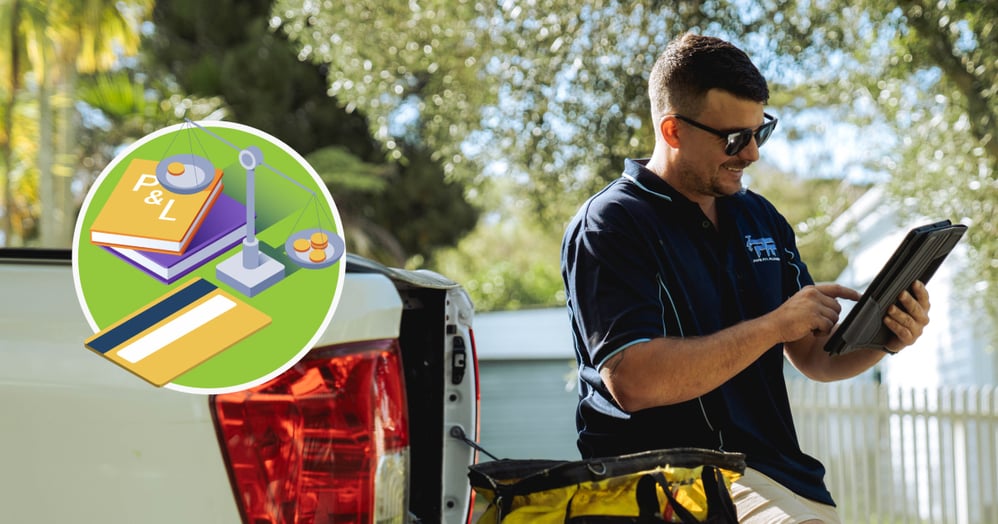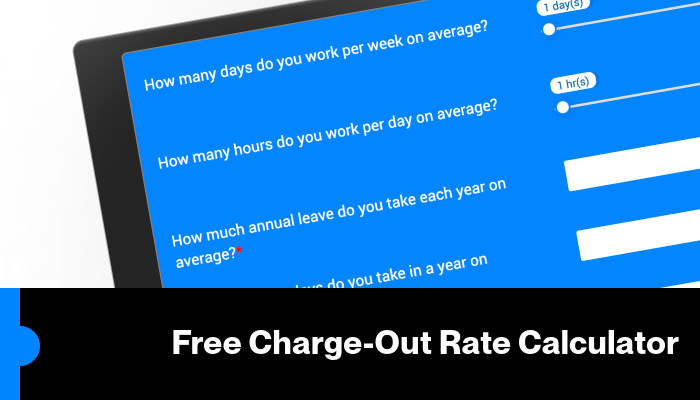End of Financial Year (EOFY) Checklist for New Zealand Small Businesses, Contractors, and Tradies
by Team Tradify, February 17, 2024

Table of Contents
When the bulk of the summer holiday season is behind us, most Kiwi tradies are already up to their ears in new work. Then, before you know it, the 31 March deadline that signals the end of the financial year (EOFY) comes lurking from around the corner.
Are you charging enough? Work out your ideal hourly rate with our free Charge-Out Rate Calculator!
If this is your first year of self-employment, you’ve likely heard some horror stories. Those who have been doing this for a while might even have a few of their own. Staying up late sorting through papers, hunting through stacks of receipts, and desperately trying to get those accounts reconciled on time. That’s enough to spark end of financial fear in any new trade business owner.
But there’s a way to make it through with your sanity intact. A way that doesn’t involve late nights and stressful searching. EOFY doesn’t need to be an admin burden.
We’ve created a checklist to help you tackle your year-end accounting and start the new financial year off right.
Short on time? Jump ahead!
- 1. Key financial dates to remember
- 2. Year-end checklist for self-employed tradies
- 3. Income tax and your IR3
- 4. Don’t forget your GST return
- 5. Review your finances
- 6. Reduce stress by ditching the pen and paper
- 7. Plan, prepare, and get through EOFY with ease
1. Key financial dates to remember
20 March
Employer deductions payment due for February for small to medium employers.
28 March
Your GST return and payment is due for the taxable period ending February.
31 March
If you have an IR3 extension through your accountant, then you have until 31 March the following year to file your IR3 form.
7 April
End-of-year income tax and Working for Families bills are due if you have an extension of time to file your income tax return.
Your FBT income year return and payment are due if you have a March balance date and a valid extension of time.
20 April
Employer deductions payment due for March for small to medium employers.
7 May
Your GST return and payment is due for the period ending 31 March.
20 May
Employer deductions payment due for April for small to medium employers.
28 May
Your GST return and payment is due for the taxable period ending 30 April.
31 May
Your FBT annual return and payment are due if you file FBT annually.
31 May
Your quarterly FBT return and payment are due for the period ending 31 December if you have a March balance date.
7 July
One of the main documents you need to file with Inland Revenue is your individual tax return – also known as an IR3 form. This form declares your income as a self-employed earner and is due 7 July (after the end of the accounting period it covers).
28 August
If you pay provisional tax, you’ll have three additional deadlines throughout the year. The first provisional tax payment for a new financial year is due 28 August.
Check provisional tax payment schedule.
What happens when you miss a deadline?
You'll want to avoid penalty fees that come with missing any of your filing deadlines. These increase over time, so if you miss more than one, it'll cost you even more and your trade business will end up on the back foot.
The impact of COVID-19 has introduced further complexities when it comes to taxation and deadlines. To find out more about how these changes may affect your business, check out the IRD website.
2. Year-end checklist for self-employed tradies
Before you can file any documents with Inland Revenue, you need to get your office in order.
1. Round-up outstanding invoices
Unpaid invoices slipped through the cracks? Now’s the time to send out reminders and follow-ups. Collect as much of the outstanding cash as you can. That way, when it’s time to reconcile your accounts, they’ll be accurate.
2. Log all business expenses
When you pay for something necessary for the everyday running of your business, it’s a business expense that you can claim tax back on. Every business expense claim reduces your tax bill and leaves more cash in your business. Here’s more information on what you can and can’t claim as a business expense in NZ.
3. Organise your paperwork
When putting together your business statements, you need to make sure you have all the paperwork to prove your incomings and outgoings. This means copies of bank and loan statements, invoices from suppliers, any credit card or hire purchase statements, records of payments to other contractors or employees and receipts for any expenses (including any asset purchases or maintenance costs).
The IRD requires you to keep a record of your income and expenses for seven years. Integrating your accounting and job management systems can streamline this process, allowing you to access your records with the click of a button.
4. Do a stocktake
For those tradespeople that keep stock and materials, you’ll need to do a stocktake. Use this opportunity to adjust stock quantities where needed and generate an up-to-date inventory list.
5. Finalise payroll
Got staff on the books? Review salary and wage information, make any legislative updates to employee pay rates and determine your Superannuation/Kiwisaver requirements.
Thinking about hiring? Download our free Interview Questions for Apprentices!
6. KiwiSaver – Government contribution
If you’re eligible to receive the KiwiSaver Government Contribution, make sure you deposit up to $1,043 into your KiwiSaver account between 1 July and 30 June each year. Now’s a good time to check if you’re doing this. The Government will match every dollar you deposit with a 50c contribution (up to $521.43). It can take KiwiSaver a couple of days to register your deposit, so it’s a good idea to make the transfer well in advance.

3. Income tax and your IR3
The tax year in New Zealand is from 1 April to 31 March. After the end of the tax year, IRD works out if you've paid the right amount of tax based on your income.
IR3. This form details all your personal income for the last financial year, how much tax you’ve already paid on that income (if any), and the business expenses you have claimed. Your profit will be used to calculate how much tax you must pay for the last accounting period – or whether you’re owed a refund.
Here’s more information on how to file your IR3 form online.
Note: if you’re already in the IRD system as self-employed, you’ll be sent an IR3 form in early April.
4. Don’t forget your GST return
If your trade business is GST-registered, you’ll have GST payment due dates throughout the year, depending on whether you file monthly, bi-monthly or every six months. The last due date for GST payments each financial year is 30 March.
Your GST payment is always due on the same day as your GST return. This is the 28th day of the month after the end of the taxable period. For example, for the taxable period ending 31 May, GST is due on 28 June.
5. Review your finances
While it might be tempting to shut your books and forget about EOFY for another year, now is the best time to review the financial health of your trade business – and assess where you could make improvements.
Once you’ve reconciled your accounts, sorted your paperwork and run your reports, you’ll have a clear snapshot of how your business performed in the last financial year. Reflect on what went well and what didn’t. Set yourself some goals and make any changes that could help you grow and run your business more efficiently.
This might include reducing expenses, purchasing new equipment, hiring an accountant, or investing in tools that will help you automate your admin processes — or make EOFY easier next year!
6. Reduce stress by ditching the pen and paper
There's no denying many trade business owners have run successful businesses using a pad and pen, but that doesn’t mean there isn’t a better way of doing things.
The problem with older admin systems is they’re often disjointed and rely heavily on manual entry. They’re difficult to maintain as you grow and it’s far too easy to make costly mistakes. You can’t charge for your admin like you can your trade, so the less time it takes you, the better.
Let technology do the heavy lifting
Streamlining your workflow processes using cloud-based tools will help you reduce admin time — and end-of-financial-year preparation too.
- Quick quotes and easy invoices. Having the capability to quote, invoice and chase payments while you’re on-site or in your van can help reduce the hours you spend chained to your desk. Also, automated payment reminders will help keep unpaid invoices to a minimum. When it’s time to reconcile your accounts, they’ll be 100% accurate.
- Speed up data processing. When you manually transfer data from your job book or timesheets into Word or Excel, you’re duplicating your work. Using a system that automatically triggers these actions (without you lifting a finger) will improve the accuracy of your data and eliminate the unnecessary doubling-up of tasks.
- Integrate accounting and job management. Working with systems that can be integrated like Tradify and Xero, will allow you to streamline processes right across your business. This means throughout the year you can reduce the time you spend on your admin, get real-time visibility of your cash flow and have greater control over your business.
7. Plan, prepare, and get through EOFY with ease.
While EOFY isn’t an admin task that you can get rid of altogether, it doesn’t need to cause you stress. Whether you’re a builder, plumber, or electrician, practice and preparation makes perfect. Make a plan to get through this busy period and then take the time to get your finances in order by using the right tools to streamline your admin processes. That way, when EOFY rolls around again next year, you’ll be ready.
Ready to ditch the paperwork and make EOFY easier? Sign up for a free 14-day trial of Tradify, or find out more in one of our weekly live walkthroughs.
Work out your ideal hourly rate with our free Charge-Out Rate Calculator!
Please note: this article is an overview of what’s required for your end-of-financial-year accounts and is not intended to be financial advice. We strongly recommend speaking to an accountant before filing your returns. For more detailed information, visit ird.govt.nz.
New Zealand End of Financial Year FAQ
The end of the financial year in New Zealand for tradies is 31st March.
You should make sure all your invoices and receipts are up to date, then ensure you have kept accurate records of all your income and expenses. Go through the checklist above to find out more!
Yes, if you're a self-employed tradie in New Zealand you will need to file a tax return.
You can claim expenses such as tools, equipment, vehicle expenses, insurance, and any other expenses related to running your business. Read our blog on expense claims for more information.
Yes, it's important to keep receipts for all your expenses as proof of your spending. Digital solutions can help store your receipts during the year to make things easier at tax time.
Your taxable income is your total income minus your deductible expenses.
The deadline for filing your IR3 tax return in New Zealand is generally 7 July, but this can vary depending on your circumstances.
Yes, you can file your tax return online using Inland Revenue's myIR system.
If you don't file your tax return on time, you may be subject to penalties and interest charges.
It's not essential, but an accountant can be helpful to help you make sure you're filing your tax return correctly and maximising your deductions. Accounting software like Xero, MYOB, and QuickBooks can also make life easier — especially when they sync up with Tradify!
Related articles

How To Set Up a Google Business Profile (for Trade Businesses)

Aussie Electrician Reduces Admin Time by 95%

Squeaky Clean Scheduling for Pro Carpet Cleaning
Give Tradify a go for free!
Save 10+ hours/week on business admin with the highest-rated job management software for tradespeople.
With free one-on-one training and phone support, it's never been easier to get started.






